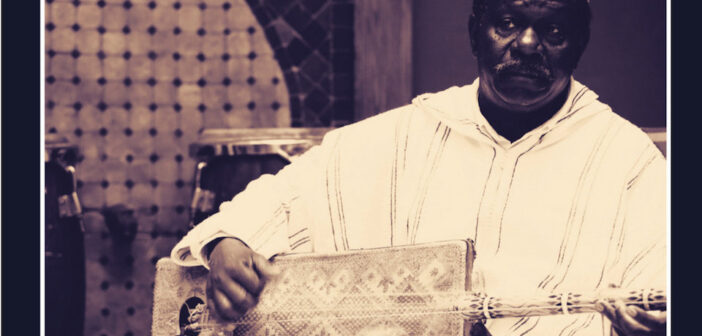When you hear the unmistakable twang of the guembri you’re immediately transported to Morocco. Yet that sound isn’t really about geography, it’s more a state of mind, and where it takes you. This is music that elevates you regardless of your level of comprehension or religious affiliations. There’s nothing else like the incredible Gnawa music of Morocco.
Maalem Mahmoud Gania was a master of this hypnotic form of ancient trance music, with clattering castanets and call and response vocals. The results are nothing short of hypnotic. Colours Of The Night was first released in 2017 and quickly sold out. It’s Maalem Mahmoud Gania’s final studio album, having passed away at the age of 64 in 2015 after a lengthy illness. You can hear the age in his voice, and it adds an additional gravitas to this joyous life affirming music. Whilst Mahmoud Gania was incredibly active within Morocco, particularly in Essaouria, Gnawa’s homeland and released his music on multiple Moroccan labels, he also collaborated with American jazz legend Pharaoh Sanders on the incredible The Trance of Seven Colours album from 1994, which is one of the most incredible cultural exchanges you will ever hear. He also recorded with German improvised jazz legend Peter Brotzmann, and most recently James Holden and Floating Points. Holden subsequently also collaborated with his son Maalem Houssam Guinia.
Colours Of The Night features extended instrumental moments, a mixture of male and female call and response back up singers and some incredible guembri work. There’s an ease to Mahmoud Gania’s playing, weaving these delicate rubbery bass webs. He takes his time, content to tangent, or perhaps the term is solo, creating whole new pathways within the music before the vocals return. It’s incredible. Gnawa music is deeply religious music, dating back to at least the 16th century when West African slaves were first brought to Morocco. It’s part of the Sufi brotherhood renowned for all night trance sessions, and you can hear the spiritual element inherent in this music.
It’s also possibly the best recorded Gnawa music I’ve heard, a document that full articulates the rubbery dexterous twang of the guembri and the at times deafening clatter of the metal castanets. It’s difficult to put into words the joy this music brings. You can enjoy music, but it’s so much more powerful than that. It’s a singular cultural artefact, presented with such respect and care that it feels like an incredible privilege to even inhabit the same world as it .




